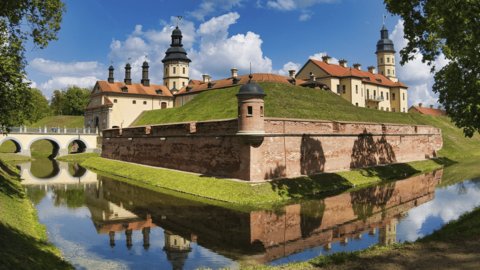
The "Medieval Belarus" excursion is a unique journey through time, transporting guests to the era of knights, princes, and powerful dynasties. Here, legends and ancient tales come to life, the footsteps of history echo, and every architectural silhouette unveils new pages of the past. You’ll experience the grandeur of defensive fortresses, immerse yourself in the atmosphere of ancient churches and palaces, and imagine the clatter of armouries and the splendour of lavish celebrations.
This excursion is more than a stroll through historical sites—it’s a deep dive into cultural heritage, where majestic architecture blends with the spirit of the ages, and natural landscapes provide a stunning backdrop for new impressions. Whether you’re a history enthusiast, an art lover, or a traveller seeking inspiration, this tour offers a chance to witness and feel the richness of Belarusian land, its unique character, and an indescribable charm that speaks to the heart.
A journey to Nesvizh is a meeting with the heart of Belarusian history and culture. The magnificent Radziwill Castle, with its grand halls and parks, stands alongside the Corpus Christi Church—a masterpiece of early Baroque—along with the Castle Tower and Slutsk Gate, which retain the defensive spirit of past centuries, and the charming Benedictine Monastery. Each site is like a page in a grand book, weaving together architecture, religion, politics, and family legends. This excursion allows you to walk the corridors of power, touch the mysteries of ancient crypts, and savour the harmony of an ensemble listed as a UNESCO World Heritage Site.
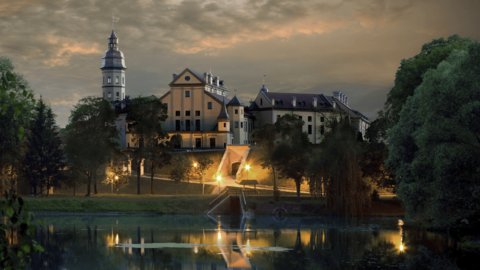
A journey to Nesvizh is a meeting with the heart of Belarusian history and culture. The magnificent Radziwill Castle, with its grand halls and parks, stands alongside the Corpus Christi Church—a masterpiece of early Baroque—along with the Castle Tower and Slutsk Gate, which retain the defensive spirit of past centuries, and the charming Benedictine Monastery. Each site is like a page in a grand book, weaving together architecture, religion, politics, and family legends. This excursion allows you to walk the corridors of power, touch the mysteries of ancient crypts, and savour the harmony of an ensemble listed as a UNESCO World Heritage Site.
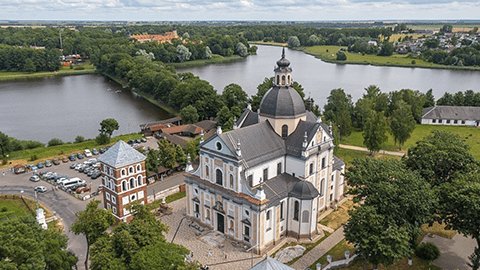
The Nesvizh Corpus Christi Church (Church of the Body of Christ) is the first proto-Baroque monument in the
Polish-Lithuanian Commonwealth, designed in the style of Rome’s Il Gesù Church, marking a new architectural era in the
16th century. Inside, you’ll find stunning 18th-century frescoes and lavish paintings, the tombs of Prince Radziwill
the Orphan and his children, and one of Eastern Europe’s largest family crypts, housing over 70 sarcophagi. The path
to this site winds through history, art, and familial grandeur.
The church’s architecture is striking in its Baroque
splendour: the façade is adorned with elegant pilasters and sculptures, while the interior captivates with intricate
frescoes by the Heski brothers, a gilded altar, and unique elements like the painting of The Last Supper and Radziwill
memorial plaques, reflecting their influence on the region’s history.
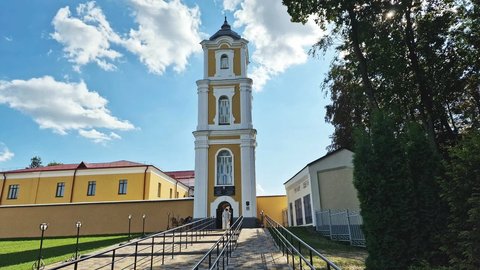
Located in Nesvizh, the Benedictine Monastery is a significant historical and cultural landmark, founded in 1593 by Mikołaj Krzysztof Radziwill “the Orphan” as part of his charitable endeavours. Built in the early Baroque style, the monastery served as a religious and educational centre where Benedictine nuns educated girls from noble families. Linked to the Nesvizh Palace and Park Ensemble, a UNESCO World Heritage Site, the monastery is a testament to the spiritual and cultural life of the Grand Duchy of Lithuania. Its buildings, including the Church of Saint Euphrosyne, retain Baroque architectural features such as elegant façades and decorative elements, despite later reconstructions and Soviet-era repurposing.
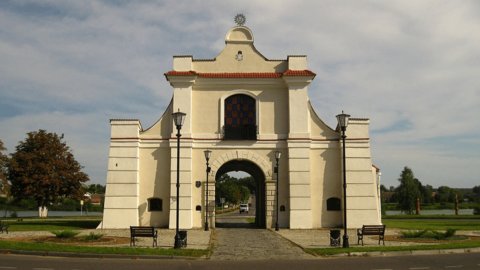
The Slutsk Gate is one of Nesvizh’s most fascinating landmarks, a must-visit for those exploring the town. Greeting visitors on the road from Slutsk, it is the only surviving gate of the five that once guarded the town’s entrances. Built in the late 16th to early 17th century, the gate originally served as a defensive tower with a drawbridge, later rebuilt in an elegant Baroque style after wartime damage. During the tour, you’ll learn about its practical significance: the ground floor housed guardrooms and a customs official collecting entry fees, while the upper floor featured a chapel dedicated to the Virgin Mary. Restored in the 1970s and early 21st century, the gate now appears much as it did centuries ago.
Open to visitors during the summer season, the Slutsk Gate is often included in guided tours of Nesvizh. Inside, a small exhibition captures the atmosphere of old Nesvizh, allowing you to imagine how travellers were welcomed in the 17th and 18th centuries. It’s a perfect stop for photos and a chance to feel the spirit of history before continuing to explore other treasures of the Nesvizh Museum-Reserve.
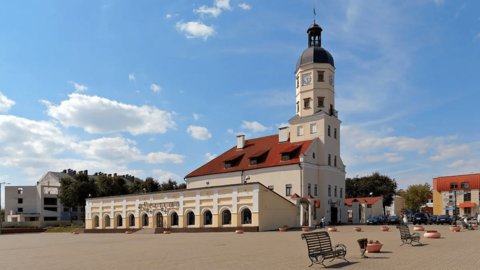
The Nesvizh Town Hall, a 16th–18th-century architectural monument, is one of the oldest surviving buildings of municipal governance in Belarus. Completed in 1596, a decade after Nesvizh received Magdeburg Rights granting extensive self-governance, the building—depicted in a drawing by Tomasz Makowski—consisted of a two-storey rectangular structure with a six-tiered tower topped with a clock and observation platform.
Throughout the 17th and 18th centuries, the town hall was the heart of civic life and a symbol of freedom. The upper floor housed the magistrate’s halls, including the council chamber, courtroom, archive, chancellery, and treasury; the basements contained a prison, storage, and guardrooms; and the ground floor featured shops and trading rows. Rebuilt in the late Baroque style in 1752, it gained a grand stone staircase and expanded trading rows forming a U-shaped courtyard. The town hall endured wars and fires, including the Northern War and a major fire in 1836 that damaged the tower and upper floor.
After World War II, it served as a House of Culture, Pioneers’ House, and library. Between 1997 and 2004, extensive restoration revived the original façade, the tower’s upper tiers with clocks, and an exhibition on the second floor dedicated to the history of municipal governance (18th to early 19th centuries). The ground floor now hosts the Batleyka family café with a children’s play area. Today, the town hall is part of the Nesvizh Museum-Reserve and remains a key centre of the town’s historical and cultural heritage.
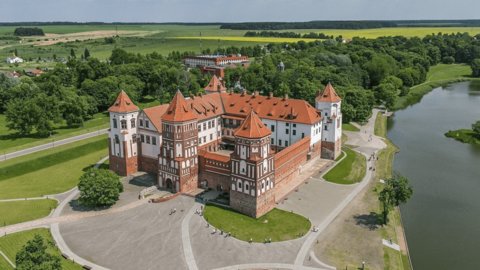
Step into the captivating atmosphere of the Middle Ages at Mir Castle, a unique architectural marvel of Belarus, built in the early 16th century. This true fortress-palace boasts massive 1.5-metre-thick brick walls, five imposing towers (four- and five-storey, one with an entrance gate), a moat, and bastions that provided robust defence. Constructed in the Belarusian Gothic style, the castle still impresses with its grandeur and authenticity.
Mir Castle is not just a monument but a living museum where eras and styles—Gothic, Renaissance, and Baroque—intertwine. Over its history, it passed from the Ilyinich family to the influential Radziwills and later to the Svyatopolk-Mirsky princes. These owners created grand residences and established regular and landscaped parks, including an Italian garden and a 19th-century pond, now open for enchanting walks.
A visit here is more than an excursion—it’s a deep dive into history and culture. Listed as a UNESCO World Heritage Site since 2000, Mir Castle is an outstanding example of Central European architecture, where centuries of cultural interaction form a harmonious ensemble. Explore museum halls filled with costumes, furniture, and weapons, enjoy theatrical tours, or even hold a romantic ceremony in a place where the past comes alive.
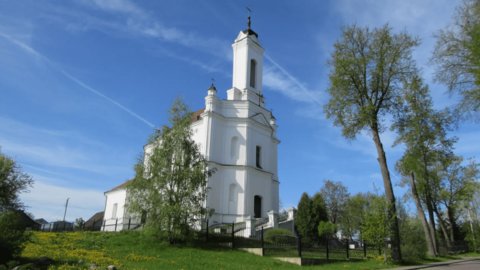
Zaslavl is not just a town but a living history rooted in the 10th century. Founded in 985 and mentioned in 12th-century chronicles as Izyaslavl, it was named after Prince Izyaslav, son of Polotsk Princess Rogneda and Vladimir the Great. The town is steeped in captivating legends: of Rogneda’s attempted assassination of the prince and of a brave young man who became one of Belarus’s earliest enlighteners.
Spanning 113 hectares, the Zaslavl Historical and Cultural Museum-Reserve tells the town’s story through the Zamok archaeological site (10th–12th centuries), the defensive Val with its former Calvinist church, burial mounds, 17th–19th-century estate remnants, and numerous museums: the Mill, Forge, Sviran ethnographic barn, DOT Museum, Children’s Museum of Mythology and Forest, exhibition complex, and Belarus’s only museum of Malyavanka folk art. Expect theatrical tours, workshops, rituals, and an introduction to myths and crafts—a vibrant immersion into the region’s unique identity.
Zaslavl preserves remarkable architectural monuments: the Transfiguration Cathedral, a striking example of Renaissance defensive-religious architecture built in the 16th century on the site of a former Calvinist fortress; and the Church of the Nativity of the Virgin Mary, an 18th-century Baroque temple, rebuilt in the 19th century, with thick walls, the Przeździecki family crypt, and restored interiors. Surrounding the town are majestic natural landscapes by the Minsk Sea, Zaslavl Reservoir—the country’s second-largest artificial lake. This tour combines a walk along ancient paths, an engaging ethno-experience, and aesthetic delight in architecture and nature.